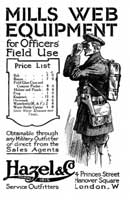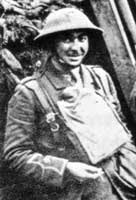| Karkee Web Home Page | Officer's Main Page | W.E.O. Main Page | W.E.O. Experimental Main Page |
Web Equipment, Officers, Experimental
“MILLS OFFICERS’ WEB EQUIPMENT”
Introduction
 The information and illustration presented here is intended to be the most comprehensive account yet seen. It is only made possible by a magnificent array of photographs, of an example in the Collection of Paul Hannon, all photographs © Paul Hannon, 2010, except where separately credited.
The information and illustration presented here is intended to be the most comprehensive account yet seen. It is only made possible by a magnificent array of photographs, of an example in the Collection of Paul Hannon, all photographs © Paul Hannon, 2010, except where separately credited.
Ordinarily, Private Purchase equipment does not appear in any War Office Priced Vocabulary. Generally taken as appearing in 1917, Paul Hannon has un-earthed an advertisement for Hazel & Co., from The Times, dated 24 July 1916, which clearly illustrates this design. This provides the Trade Name in quotes above. In this instance, most un-usually, a post-1918 Priced Vocabulary does exist, which listed an “…Experimental…” pattern. Whilst there is no absolute corroboration that the two nomenclatures are one and the same, it at least seems probable, no other candidate being in the frame, so to speak. This is therefore written to provoke input, should anyone know better / more.
Many firms were supplying “Sam Browne” Belts to Regimental Outfitters, with a few supplying alternative patterns. Given the Mills’ company’s known drive to conquer the market for web equipment, it is hardly surprising that they should have developed a full Pattern specifically for officers. This drew upon and adapted their existing designs, there being little business acumen in completely re-inventing the wheel!
Fortunately, Lethern included brief comment in the Company’s Golden Jubilee book:-
 “…An important development of the equipment for the Infantryman was an equipment for Officers. The British Army Officers’ regulation equipment was the leather “Sam-Browne” Belt (Sic - it being incorrect to hyphenate this!) with a pistol case and ammunition pouch carried on the belt, field-glass case and a haversack and a waterbottle in a carrier added for Service requirements (these were not part of the S.B. “system”), all carried with slings across the chest. Such an outfit was too conspicuous to use under Service conditions and actually resulted in many Officer casualties in the early days of the War, through being easy marks for sharpshooters. Officers were forced to use the Infantryman’s equipment, even with the pack, but our Web Equipment for Officers was eventually adopted, and many thousand(s of) sets were sold to Officers individually and through military tailors…”
“…An important development of the equipment for the Infantryman was an equipment for Officers. The British Army Officers’ regulation equipment was the leather “Sam-Browne” Belt (Sic - it being incorrect to hyphenate this!) with a pistol case and ammunition pouch carried on the belt, field-glass case and a haversack and a waterbottle in a carrier added for Service requirements (these were not part of the S.B. “system”), all carried with slings across the chest. Such an outfit was too conspicuous to use under Service conditions and actually resulted in many Officer casualties in the early days of the War, through being easy marks for sharpshooters. Officers were forced to use the Infantryman’s equipment, even with the pack, but our Web Equipment for Officers was eventually adopted, and many thousand(s of) sets were sold to Officers individually and through military tailors…”
Two basic forms are known, the methodology of the “three-piece” construction having changed, along with the original “loop & olivet” main buckle being replaced by the 1919 patented “hook & loop” form. This later upgrade in fittings, component parts and even in “finish” will be dealt with separately.
A challenge to readers: For the Great War, just one photo has ever been noted. This was a King’s Regiment officer at Givenchy in March 1918 (upper right). Even this is only recognisable by the ring on the Brace attachment, the set not having the Binocular case and Holster assemblies. You’ve managed it with Patt. ’40, can you come up trumps for W.E.O. in the Great War?
© R.J. Dennis February 2009